Cite this document
(“Argentina Case Study Essay Example | Topics and Well Written Essays - 2000 words”, n.d.)
Retrieved from https://studentshare.org/sociology/1446971-reduce-child-mortality-cut-the-under-five-death
Retrieved from https://studentshare.org/sociology/1446971-reduce-child-mortality-cut-the-under-five-death
(Argentina Case Study Essay Example | Topics and Well Written Essays - 2000 Words)
https://studentshare.org/sociology/1446971-reduce-child-mortality-cut-the-under-five-death.
https://studentshare.org/sociology/1446971-reduce-child-mortality-cut-the-under-five-death.
“Argentina Case Study Essay Example | Topics and Well Written Essays - 2000 Words”, n.d. https://studentshare.org/sociology/1446971-reduce-child-mortality-cut-the-under-five-death.


